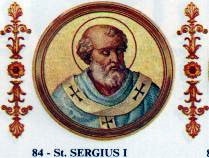Pope Sergius I
|
Pope Saint Sergius I |
|
|---|---|
 |
|
| Papacy began | 15 December 687 |
| Papacy ended | 8 September 701 |
| Predecessor | Conon |
| Successor | John VI |
| Orders | |
| Created Cardinal | 27 June 683 by Pope Leo II |
| Personal details | |
| Born | 650 Palermo, Sicily, Byzantine Empire |
| Died | 8 September 701 Rome |
| Previous post | Cardinal-Priest of Santa Susanna (683–687) |
|
Papal styles of Pope Sergius I |
|
|---|---|
 |
|
| Reference style | His Holiness |
| Spoken style | Your Holiness |
| Religious style | Holy Father |
| Posthumous style | Saint |
Pope Sergius I (c. 650 – 8 September 701) was Pope from December 15, 687 to his death in 701. He was elected at a time when two rivals, the Archdeacon Paschal and the Archpriest Theodore, were locked in dispute about which of them should become pope.
His papacy was dominated by his response to the Quinisext Council, whose canons he refused to accept. Thereupon the Byzantine Emperor Justinian II ordered Sergius' abduction (as his predecessor Constans II had done with Pope Martin I), but the Roman people and the Italian militia of the Exarch of Ravenna refused to allow the exarch to remove Sergius to Constantinople.
Sergius I came from an Antiochene Syrian family which had settled at Palermo in Sicily. Sergius left Sicily and arrived in Rome during the pontificate of Pope Adeodatus II. He may have been among the many Sicilian clergy in Rome, at that time, due to the Islamic Caliphate battles against Sicily in the mid-7th century.Pope Leo II, ordained him cardinal-priest of Santa Susanna on 27 June 683, and he rose through the ranks of the clergy. He remained cardinal-priest of Santa Susanna until his selection as pope.
When on 21 September 687, after a long illness and a reign of less than a year, Pope Conon died, his archdeacon Paschal had already bribed the Exarch of Ravenna, John II Platyn, to make him Pope Conon's successor. However, a more numerous faction wanted the Archpriest Theodore to become pope. The two factions entered into armed combat, each in possession of part of the Lateran Palace, which was the papal residence. To break the deadlock, a group of civic authorities, army officers, clergy, and other citizens met in the Palatine imperial palace, elected Sergius and then stormed the Lateran, forcing the two rival candidates to accept Sergius.
...
Wikipedia
